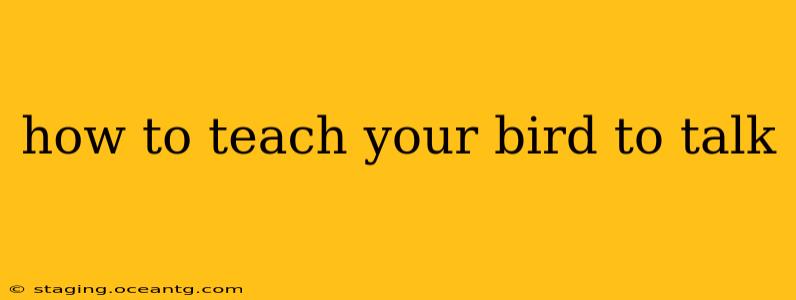Teaching your bird to talk is a rewarding experience, building a unique bond and enriching your feathered friend's life. However, it requires patience, consistency, and understanding of avian learning. This comprehensive guide will equip you with the knowledge and techniques to successfully teach your bird to speak.
What Kind of Bird Learns to Talk Best?
Which bird species are best suited for talking? Certain species are naturally predisposed to vocal learning. Parrots, particularly African Greys, Amazons, and Cockatoos, are renowned for their exceptional talking abilities. Mynah birds and some species of starlings are also known for their vocal mimicry skills. However, even within a species, individual birds vary in their aptitude for learning.
How to Start Teaching Your Bird to Talk
What is the best age to start training a bird to talk? Ideally, start young. Birds learn best during their formative years, typically from fledgling to about one year old. While older birds can learn, they may require more patience and a different approach.
What are the best methods for teaching a bird to talk? A combination of methods yields the best results. These include:
- Positive Reinforcement: Reward desired behaviors with treats, praise, and physical affection. Never punish your bird for mistakes; this can damage your bond and hinder learning.
- Repetition: Repeat words and phrases clearly and consistently throughout the day. Use a calm, encouraging tone.
- Modeling: Speak naturally in your bird's presence, using clear and concise language.
- Visual Aids: Use flashcards or pictures to associate words with their visual representations.
- Auditory Stimulation: Play recordings of words and phrases to provide additional learning opportunities.
- Patience: Learning takes time. Don't get discouraged if your bird doesn't learn immediately. Celebrate small victories along the way.
Tips and Tricks for Successful Bird Training
How can I make the learning process more engaging for my bird?
- Keep sessions short and frequent: Birds have short attention spans. Multiple short training sessions are more effective than one long session.
- Create a stimulating environment: Provide toys, perches, and opportunities for exploration to keep your bird engaged and motivated.
- Be consistent: Stick to a regular training schedule to help your bird form positive associations with learning.
- Use a variety of methods: Experiment with different techniques to find what works best for your bird.
- End on a positive note: Always finish training sessions with a successful interaction, leaving your bird feeling good about the experience.
Common Mistakes to Avoid When Teaching Your Bird to Talk
What are common mistakes people make when trying to teach their birds to talk?
- Inconsistent training: Lack of consistency hinders progress. Establish a regular routine and stick to it.
- Using harsh methods: Punishing your bird will damage your relationship and discourage learning. Focus exclusively on positive reinforcement.
- Expecting too much too soon: Learning takes time and patience. Celebrate small successes.
- Ignoring your bird’s cues: Pay attention to your bird’s body language. If your bird is tired or uninterested, stop training.
- Lack of environmental enrichment: A bored bird is less likely to learn. Provide a stimulating environment with plenty of toys and opportunities for exploration.
Understanding Your Bird's Communication
How can I tell if my bird understands what I'm saying? While not always obvious, signs of understanding include mimicking sounds, responding to commands, and displaying specific behaviors when certain words or phrases are used. Your bird may also exhibit body language cues, such as head tilting or specific vocalizations, that indicate understanding.
Beyond Talking: Enriching Your Bird's Life
Teaching your bird to talk is just one aspect of building a strong bond and enriching its life. Provide ample opportunities for social interaction, mental stimulation, and physical exercise to ensure your bird thrives. Remember, a happy and healthy bird is more likely to engage in learning and develop its communication skills. Providing a stimulating and loving environment is paramount to success in teaching your bird to talk, and more importantly, to ensure a happy and fulfilling life for your feathered companion.
